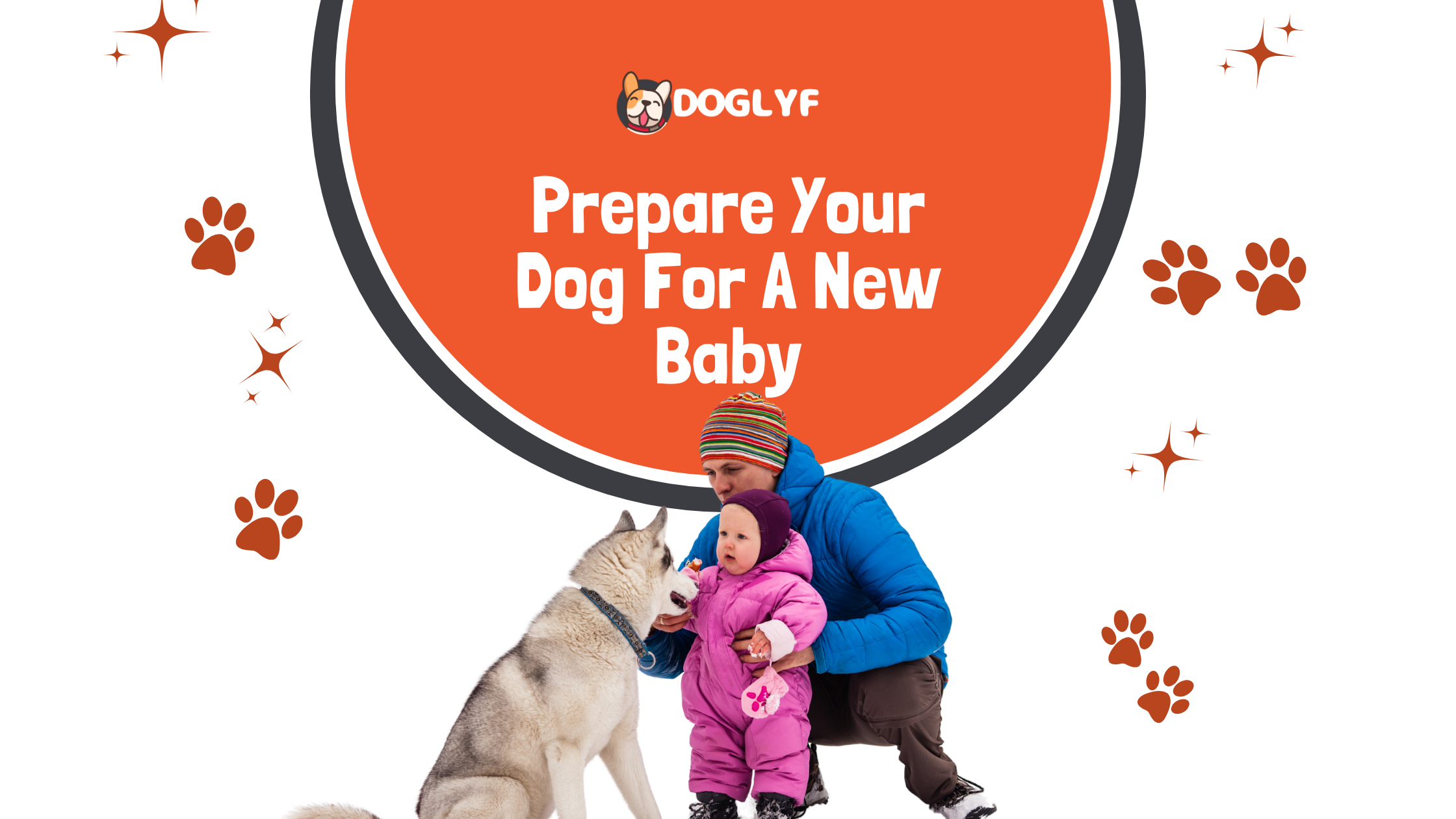This post may contain affiliate links. For more information about my affiliate disclosure, please click here
Congratulations on your pregnancy! As you prepare for the arrival of your new baby, it’s important to also consider how your furry friend will adjust to this major life change.
Dogs are sensitive creatures and can easily become overwhelmed with a new addition to the family. However, with proper preparation and training, you can help make the transition smoother for both your dog and baby.
In this article, we’ll provide tips and strategies on how to prepare your dog for a new baby. We’ll cover topics such as introducing your dog to baby gear, establishing new rules and boundaries, gradual exposure to baby sounds and smells, practicing obedience commands, encouraging positive interactions with children, managing separation anxiety, seeking professional help if needed, monitoring your dog’s behavior around the baby, and celebrating success and progression.
Dog’s Pregnancy 101 For Owners! How Long Are Dogs Pregnant?
By following these guidelines, you can ensure that both your furry friend and new bundle of joy can coexist happily in their shared home.
- On-Demand Videos
- 24/7 Support
- Improves Dog’s Mental Health
- Improves Dog’s Mental Illness
- Dog Training Tricks and Games to Improve Dog’s Response
- In-depth Video Training
- Available on All Devices
- Includes One Time Fee
Table of Contents
Key Takeaways
- Introduce your dog gradually to baby gear, sounds, and smells, and establish new rules and boundaries for your dog.
- Always supervise playtime between your dog and children and establish separate areas where your dog can retreat to if they feel overwhelmed.
- Manage separation anxiety in your dog through toys, treats, routine, exercise, and professional help if necessary.
- Reinforce positive behaviors through celebrating milestones, positive reinforcement, and acknowledging progress made in preparing for a new arrival.
Introducing Your Dog to Baby Gear
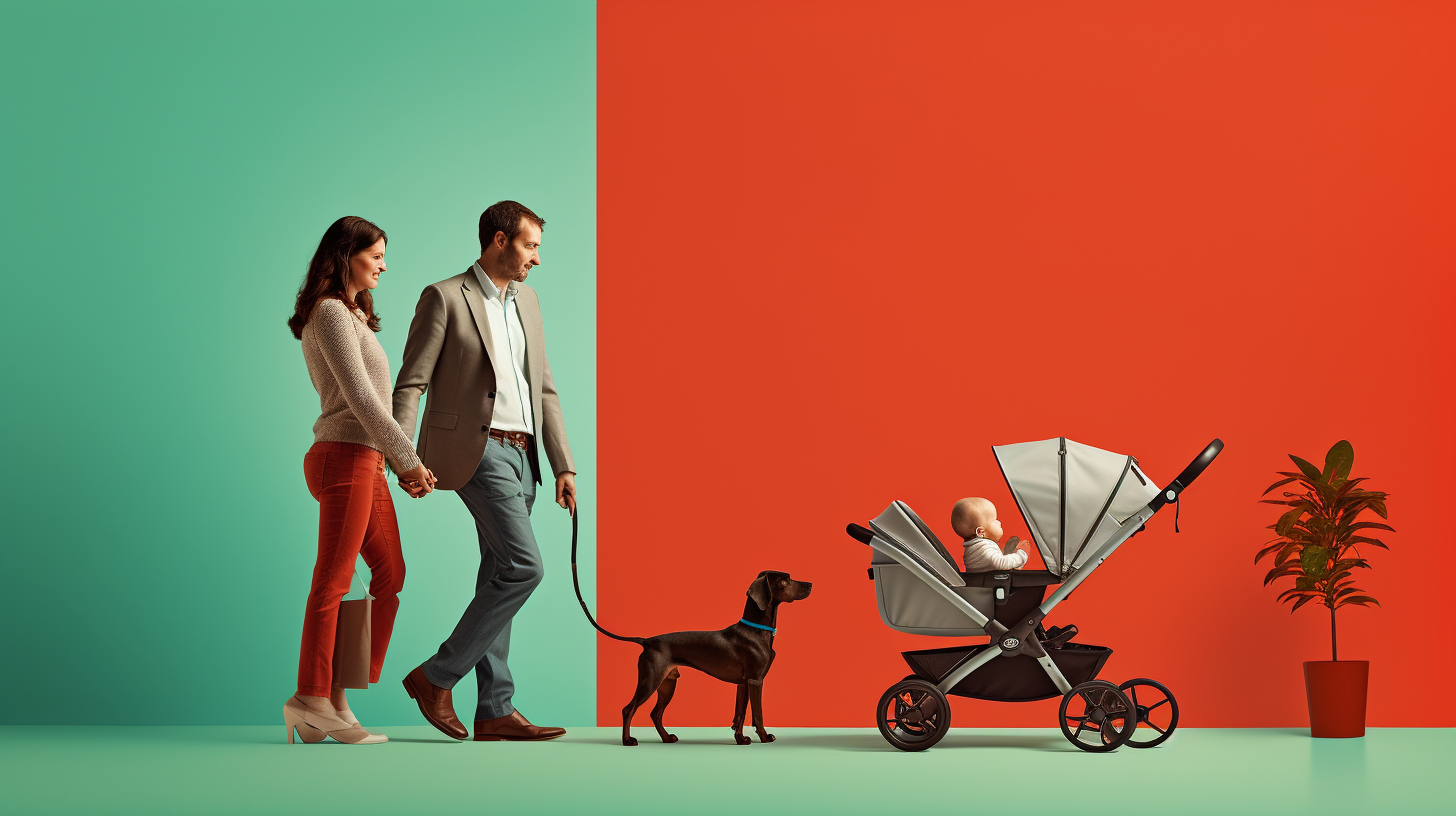
Don’t freak out, but it’s time to start showing your pup all the baby gear. Choosing appropriate baby gear for dogs is essential, so make sure you do your research and find items that are safe for both your baby and your dog. Once you have the gear, introduce it to your dog in a positive way.
Can Dogs Have Almond Milk? Benefits And 2 Potential Risks
Preparing your dog for strollers and carriers can be particularly tricky. Start by placing treats inside the stroller or carrier when it’s stationary so they can get used to being around it.
- Then, take short walks together with the stroller empty before gradually increasing the amount of time spent walking with both baby and dog in tow. Remember to reward good behavior with lots of praise and treats.
Introducing new gear may require adjustments from your furry friend, but with patience and consistent training, they will learn to coexist peacefully with their new little sibling.
Next up: establishing new rules and boundaries without neglecting your furry friend!
Establishing New Rules and Boundaries
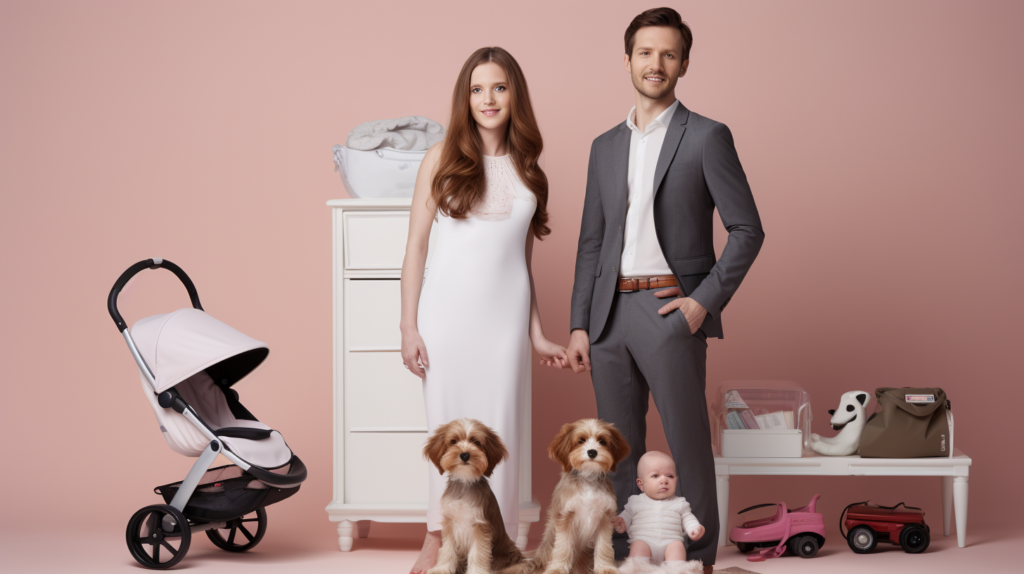
Now that there’s a little one on the way, it’s time to set up some fresh guidelines and limits for your furry friend. This is especially important if your dog hasn’t had much experience with babies.
Setting boundaries and enforcing rules will help ensure everyone’s safety and happiness once the baby arrives. Start by establishing basic rules for your dog, such as not jumping on furniture or not begging at the dinner table. These may seem small, but they create consistency in your dog’s behavior and help establish you as the pack leader.
5 Best Slow Feed Dog Bowls for your beloved Pooch!
You should also start limiting access to certain areas of the house where the baby will be spending most of their time. Another important rule to enforce is no rough play. Even if your dog has been well-behaved in the past, a new baby can throw off their routine and cause them to act out.
Make sure you’re always supervising playtime with your pup so that they don’t accidentally hurt anyone or damage any baby gear. As you begin setting these new rules, remember to do so in a positive manner by rewarding good behavior rather than punishing bad behavior.
Stay consistent with these boundaries so that both you and your dog are prepared for when the baby comes home. Gradual exposure to baby sounds and smells will be easier once these initial boundaries are established without causing stress for anyone involved.
Gradual Exposure to Baby Sounds and Smells
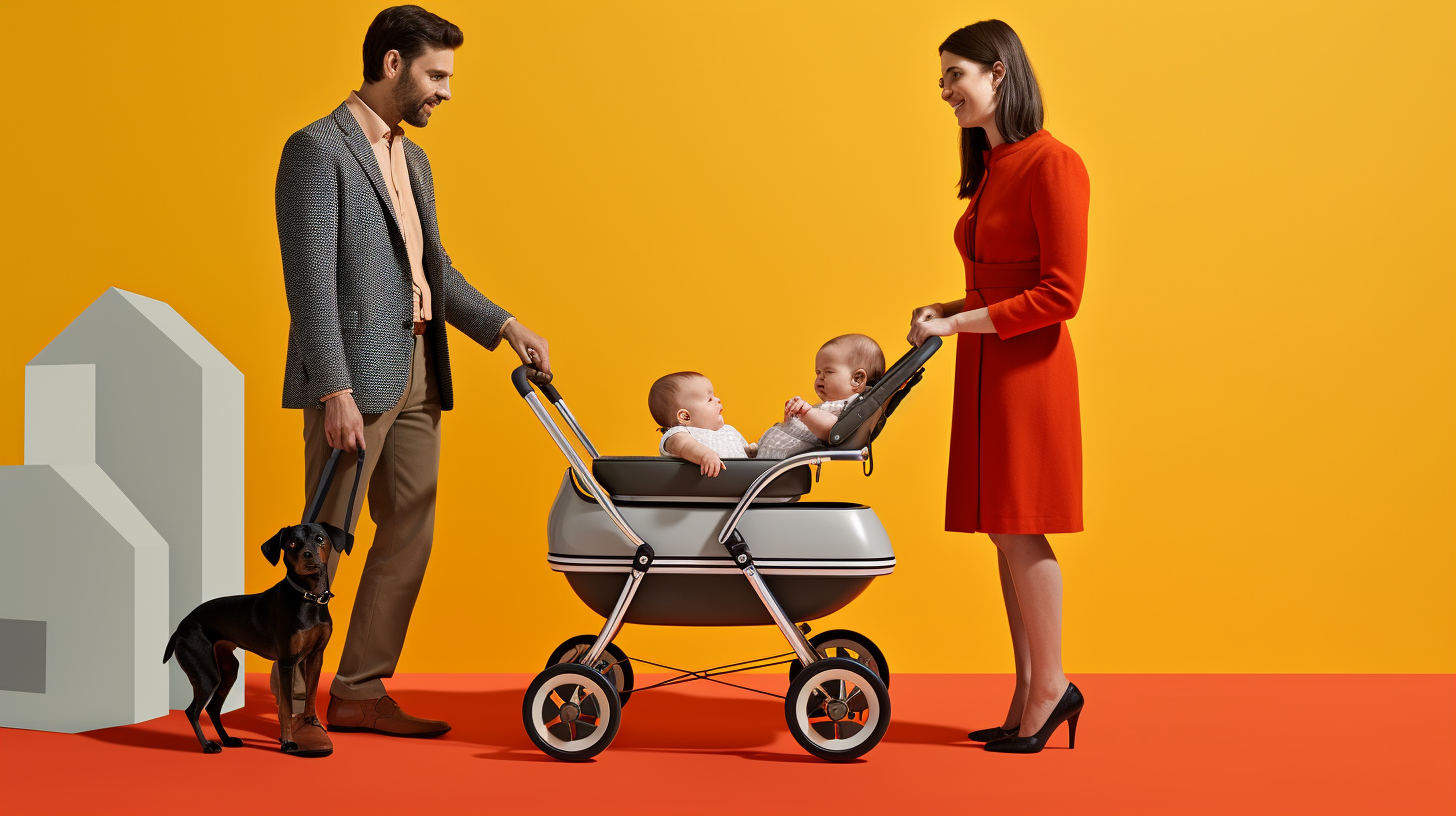
Gradually introducing your furry friend to a new baby’s sights, sounds, and smells can help ease their anxiety and prepare them for the upcoming changes in your household.
Familiarizing scents such as baby powder, lotion, and even dirty diapers can be done by placing these items near your dog’s sleeping area or playpen. This will allow them to get used to the scent without being overwhelmed.
Desensitizing sounds like crying or cooing can also be done gradually. Start by playing recordings of baby sounds at a low volume while your dog is in another room. As they become more comfortable with the sounds, increase the volume slowly over time. This will help them associate the sounds with positive experiences rather than fear or anxiety.
By gradually exposing your dog to new baby smells and sounds, you are helping them adjust to their new sibling before they even arrive. But remember that this is just one step in preparing your fur baby for this big change! The next step is practicing obedience commands so that they can safely interact with the new addition to your family.
Practising Obedience Commands

It’s essential to reinforce obedience commands with your furry companion, so they understand the rules and can safely interact with their new sibling. Dogs thrive on structure and consistency, and they need clear boundaries to feel secure in their environment.
Practising obedience commands such as ‘sit,’ ‘stay,’ and ‘come’ will help your dog understand what is expected of them when interacting with the baby. Consistency is key when it comes to reinforcing good behaviour in your dog.
How To Stop Dog Barking: 6 Remarkable Techniques & 1 Surprising Solution for Instant Peace & Quiet!
Make sure everyone in the household is using the same commands and rewarding good behaviour consistently. Positive reinforcement techniques such as treats or verbal praise can encourage your dog to behave appropriately around the baby. However, avoid punishing or scolding your dog for misbehaving, as this can create anxiety and fear.
By practising obedience commands regularly, you’ll be setting your furry friend up for success when it comes time to introduce them to their new sibling. The importance of consistency cannot be overstated – dogs learn through repetition and need clear expectations from their owners.
In the next section, we’ll discuss strategies for encouraging positive interactions between your dog and children without compromising safety.
Encouraging Positive Interactions with Children
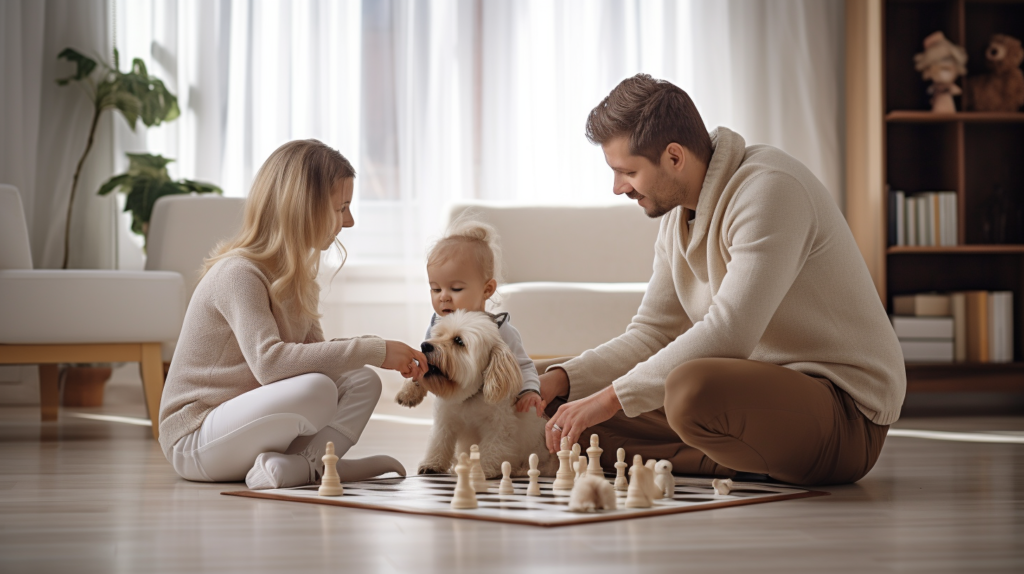
Encouraging your furry friend to interact positively with children is all about creating a fun and safe environment for everyone involved. One of the best ways to achieve this is through positive reinforcement. Whenever your dog interacts with a child in a calm and friendly way, reward them with treats or praise. This will encourage them to continue behaving well around children.
Supervised playtime is also important when it comes to encouraging positive interactions between dogs and children. Always keep an eye on your dog when they’re playing with kids, especially if they’re young or excitable. If you notice any signs of aggression or discomfort from either the dog or the child, intervene immediately by separating them and giving both parties some space.
Creating safe spaces for your dog and baby is crucial when preparing for a new addition to the family. This means setting up separate areas where your dog can retreat to if they feel overwhelmed or need some alone time. You should also teach your child early on about boundaries and how to respect their furry sibling’s personal space.
By taking these steps, you can help ensure that everyone feels comfortable and safe in each other’s company, allowing for many happy years together as a family.
Creating Safe Spaces for Your Dog and Baby
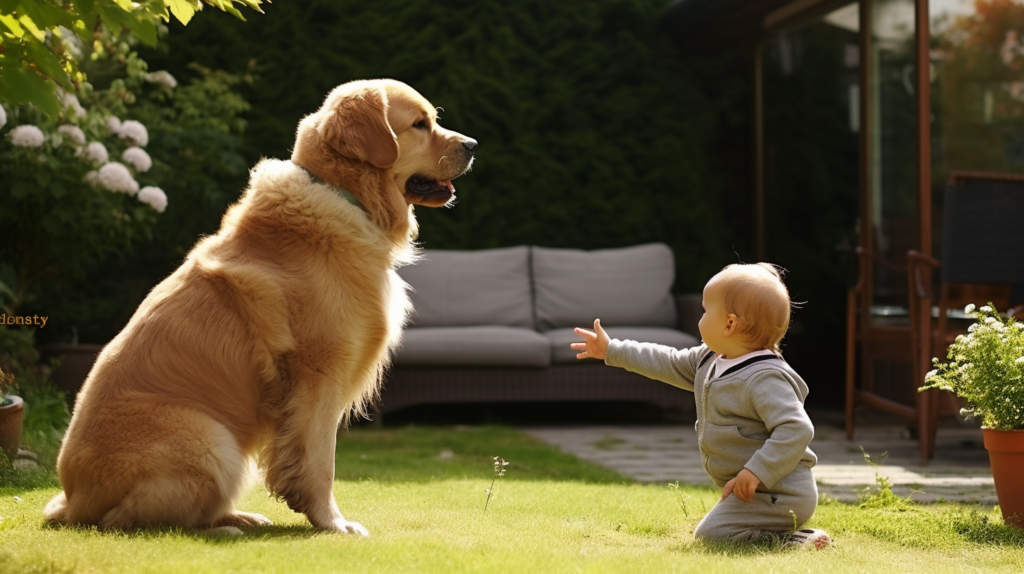
Safe spaces for your pup and precious progeny can be established by setting up designated areas where they can peacefully retreat. For your dog, it could be a cozy crate or a comfortable bed in a separate room. For your baby, it could be a playpen or crib that is gated off from the rest of the house.
These designated areas should always be supervised to ensure that both your dog and baby are safe. When creating these safe spaces, keep in mind that dogs need their own space just as much as babies do. By providing them with their own area, you’re giving them the opportunity to relax and unwind in peace. This will also prevent any unwanted interactions between your pup and baby, decreasing the likelihood of any accidents happening.
Remember that supervision is key when it comes to ensuring the safety of both your dog and baby. Even if they are separated by gates or crates, accidents can still happen if left unsupervised. It’s important to always keep an eye on them when they’re together to make sure everyone is happy, healthy, and stress-free.
In our next section about managing separation anxiety, we’ll discuss ways to help ease any stress or anxiety that may arise when separating your dog from your new bundle of joy without causing distress for either party involved.
Managing Separation Anxiety
When managing separation anxiety, it’s important to gradually introduce your dog to being away from you and teaching them that it’s okay to be alone for short periods of time. This can be achieved by starting with leaving your dog in another room while you stay close by, and then slowly increasing the distance and duration of separation.
You can also try leaving some toys or treats with your dog so they feel more comfortable when left alone. Another way to manage separation anxiety is by creating a routine for your dog. Dogs thrive on routine and predictability, so establishing a consistent schedule for feeding, walking, playtime, and alone time can help reduce their stress levels.
Additionally, providing plenty of exercise and mental stimulation can also help alleviate anxiety. If these solutions do not work or if your dog exhibits severe symptoms of separation anxiety such as destructive behavior or excessive barking, seeking professional help may be necessary.
A veterinarian or animal behaviorist can provide additional advice on how to manage stress in dogs and develop a personalized treatment plan that works best for you and your pet. Remember that addressing separation anxiety early on will lead to a happier life for both you and your furry companion.
Seeking Professional Help if Needed
If all other methods fail to alleviate your dog’s separation anxiety, seeking professional help from a veterinarian or animal behaviorist may be necessary. These professionals can evaluate your dog’s behavior and provide a personalized plan to help them cope with their anxiety.
Benefits of seeking professional help include having access to the latest techniques and medications that can provide relief for your dog. However, there may also be potential challenges in seeking professional help. For example, some dogs may not respond well to certain medications or therapies, which could lead to further behavioral issues. Additionally, the cost of veterinary care and behavior therapy can be expensive.
Regardless of these challenges, it is important to remember that seeking professional help is a viable option for managing your dog’s separation anxiety. By doing so, you’re taking an active role in ensuring the safety and well-being of both your dog and new baby.
As you move forward with this process, it’s crucial to monitor your dog’s behavior around the baby closely.
Monitoring Your Dog’s Behavior around the Baby
Now that you’ve sought professional help, it’s important to keep a watchful eye on your furry friend’s behavior around the little one. Behavioral training and professional consultation can only do so much. It’s up to you to monitor your dog’s actions and reactions towards the baby.
Here are some tips on how to ensure your dog and baby coexist safely:
- Never leave your dog alone with the baby: No matter how well-trained or docile your pet may be, there’s always a risk of an accident occurring. Always supervise interactions between the two.
- Teach boundaries: Establish limits for where your dog can go when the baby is present. For instance, keep them off furniture when holding or feeding the little one.
- Reward good behavior: Positive reinforcement goes a long way in shaping desirable habits in dogs. Praise your pup when they exhibit calm behavior around the baby, and reward them with treats as necessary.
Remember, it takes time for both your pet and newborn to adjust to each other’s presence in the home environment. Celebrating success and progression will come naturally as long as you remain vigilant and committed to helping both parties coexist harmoniously without any incidents or accidents occurring along the way.
Celebrating Success and Progression
You’ve put in a lot of effort to ensure your furry friend and little one coexist harmoniously, so don’t forget to celebrate the milestones you achieve together – it’s a great way to keep up the positive momentum and show your dog how much you appreciate their progress!
Celebrating milestones is an essential part of the process because it helps reinforce positive behaviors. It also motivates your dog to continue exhibiting good behavior around the baby.
Positive reinforcement is crucial when celebrating milestones. This technique involves rewarding desirable behavior with something that your dog enjoys, such as treats or praise. Positive reinforcement will help establish a connection between good behavior and rewards, making it more likely for your dog to repeat those behaviors in the future.
When celebrating milestones, reward your dog immediately after they exhibit desirable behavior so they can associate their actions with positive outcomes.
It’s important to remember that every achievement deserves recognition, no matter how small it may seem. Celebrate each milestone as they come, whether it’s when your dog approaches the baby calmly or when they stay relaxed while you’re holding the baby.
By doing this, you’ll be able to acknowledge all of the hard work and progress that both you and your furry friend have made while preparing for a new arrival. Keep up the positivity, and soon enough, coexisting with a newborn will become second nature for both you and your pup!
Frequently Asked Questions
How can I tell if my dog is anxious around my new baby?
To identify anxiety in your dog around a new baby, look for signs such as pacing, panting, and avoidance. Reassure your dog with positive reinforcement and give them a safe space away from the baby. Seek professional help if necessary.
Should I allow my dog to sleep in the same room as the baby?
Wondering if it’s safe for your dog to sleep in the same room as your baby? There are pros and cons, but safety precautions should always come first. Keep a close eye on both baby and dog, and consider using a baby gate or crate.
What should I do if my dog shows signs of aggression towards the baby?
If your dog displays aggression towards the baby, take immediate action. Consider training methods to address behavior issues. Seek professional help if necessary. Always prioritize safety for both your dog and child.
Can I still take my dog on walks with the baby?
Walking your dog with a new baby is like walking a tightrope. Dog walking etiquette is essential, but you don’t have to give up on walks altogether. Consider alternative exercise options and gradually introduce your pup to the new routine.
How long does it usually take for a dog to adjust to a new baby?
Introducing a new baby to your dog can be stressful, but typically takes a few weeks for them to adjust. Tips for introducing include gradual exposure and positive reinforcement. Common mistakes to avoid are neglecting your dog’s needs and allowing rough play with the baby.
Conclusion
Congratulations! You’ve successfully prepared your furry friend for the arrival of your little bundle of joy. It wasn’t an easy journey, but your hard work has paid off as you now have a happy and well-behaved dog that loves being around children.
As you continue to navigate parenthood with a pet, remember to keep an eye on their behavior around the baby and continue reinforcing positive interactions.
Remember how far you’ve come and celebrate every success and progression.
In the words of Cesar Millan, “A dog doesn’t care if you’re rich or poor, educated or illiterate, clever or dull. Give him your heart and he will give you his.”
Your dog is an important member of your family, and with proper preparation, they can be great companions for both you and your little one.
